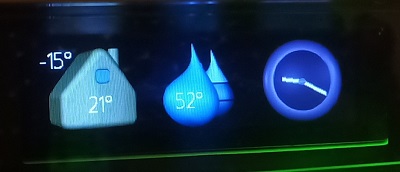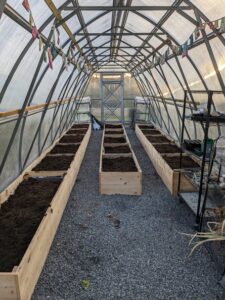Heap Pump Settings
This article contains the settings we used for a NIBE ground source heat pump (GSHP) in Sweden to get a compromise between lower energy use without noticeably sacrificing comfort. Moreover, the article has a description of what the settings mean and the decision behind the settings. This is a work in progress and I’ll update the article in case it helps others.
When we purchased the house, a NIBE F1245 heat pump was already present. Numbers and advice include that from the NIBE energy savings tips and the NIBE manual for the F1245. All descriptions of potential savings are an estimation based on a Swedish 1940s house, originally consuming 14000kWh per year before other improvements. In summer there is no heating need, and in winter there is the highest heating requirement.
Ideally, I would update this article with accurate electricity consumption numbers by monitoring the individual electrical supply feed to the GSHP, but I don’t have this capability at the time of writing. For ourselves, the combined settings may save us in the region of 10-15% of our consumption, depending on the outside temperature and other factors. My estimate is 1220kWh in heating cost saved per year.
Decisions to Make in Advance
First, we had to make some decisions about what to implement before altering the settings on the heat pump. To help you decide on your own situation, I have described these in detail below.
House Temperature
Firstly we should decide on a house temperature. We had it set to 21C when we first moved in. The general consensus seems to be that 18-21C is recommended for houses in winter. 17-19C for bedrooms. The World Health Organisation says that 18C is fine for reasonably dressed persons.

Going colder increases the risk of various health problems. Some studies cite an elevated risk of respiratory illness below 17C and further problems at lower temperatures. Mechanical considerations can also apply; with some exceptions, most freezers will have a rated minimum room temperature of 16C due to the construction of the compressor.
There are some arguments for a warmer average temperature. 20-21C is often stated to be the ideal for the main living room. We work from home and 22C is supposed to be the ideal temperature for offices although there is much debate. This is also an old building without an internal moisture barrier, so it operates better when kept warm and vapour can leave the structure.
We agreed on 19C and slowly dropped the house temperature by 0.5C at a time over a week, checking how the house was behaving every couple of days. It was fine for a while but in the middle of winter the house sometimes got a bit too cold in places so we went slightly higher to 19.5C which has worked great. NIBE documentation suggests a 5% reduction or increase in consumption per degree. There will be lots of factors but approximately the 1.5C reduction should save in the region of 7.5% of electricity use by the GSHP. The new temperature might represent a saving of 750kWh per year for our own property.
House Heating Schedule
A GSHP extracts heat relatively slowly over time and so NIBE recommends avoiding large temperature oscillations. In contrast in a natural gas boiler system, it can be common to set a significant temperature drop overnight. The problem with performing a large temperature drop overnight with a GSHP is that for the GSHP to accommodate large increases in temperature in the morning, it will probably have to switch to en electrical element instead of the pump. This condition is less efficient and more expensive, using more electricity rather than saving it.
Note that the electric unit price overnight might also be cheaper depending on your electricity plan. This discount might mean the inputting heat into the building during off-peak times saves more money than the reduction in temperature would have saved in lower units of electricity used. The ideal would be to closely monitor power consumption and cost for this setting to determine the exact impact.
We decided to try it. We set a small heat reduction overnight. So for 22:00-04:00, the system lets the house drop by 1C down to 18.5C. Using the NIBE suggested consumption statistics, a 1C reduction for 6 hours might provide an approximate saving of 100kWh per year for our property.
Hot Water Schedule
We set the hot water to a default of “economy” instead of “normal”. NIBE states this should save in the region of 150kWh per year. However, when we tried this the hot water went colder near the end of our peak usage. So instead we set a schedule of “normal” for the time when morning showers would be needed and increased the window of this a few hours earlier so that hopefully the GSHP had time to extract the heat via the pump instead of using the grid power. I also set the hot water to be off in the early nighttime. Again, monitoring electric consumption versus grid unit-price would be the best way to fine-tune this setting. With the settings below we may save 150-180kWh a year as an estimate.
- General setting: “economy”
- schedule1: 19:45 – 04:00 “off”
- schedule2: 05:00 – 06:00 “normal”, Monday to Friday
Remove Radiator Thermostats
NIBE documentation recommended removing individual radiator individual thermostats (TRV) and instead using manual valves. As a simplification the two systems fight; thermostatic valves shut off flow through radiators at a temperature set on the valve, but the temperature sensor on the GSHP is already regulating temperature via the water temperature and system flow. Note also that the GSHP is most efficient when sending constant water to large radiators with the water temperature a little warmer than the target temperature.
We removed the thermostatic valves and fitted simple manual ones wherever possible. We then opened the valves fully. This way the GSHP was in full control of monitoring and reacting to house temperatures. There was also great water flow so a more consistent temperature water feed could reach all rooms.
General Maintenance
The main cost of the GSHP is the installation work and the value of the core appliance unit. To avoid having to buy a new unit for as long as possible it is important to maintain the unit. Some maintenance tasks we can do ourselves but booking a plumber is easy. The annual maintenance is generally:
- Bleed the radiators to remove trapped air
- Top up the solution used in the ground loop
- Clean out the magnetic filter in the heating system
- Check for software updates for the GSHP

To reduce the risk of corrosion, we removed old steel water pipes leading to the GSHP. We also fitted a magnetic filter in the heating system to remove debris. It’s worth talking to the plumber each year to get their opinion on the system, and maybe rotating plumbers each year to get different opinions (providing that doesn’t cause social issues in small towns).
Setting the Values
The setting references correspond to the menu reference on the F1245 GSHP. Our installation uses the settings shown in bold. The table also shows some significant but unchanged items as reference.
| Setting Reference | Setting Name | Set | NIBE Default | Notes |
| 1.1 | Temperature | 19.5C | 20C | Intended house temperature. |
| 1.3.1 | Schedule | 20:00 – 04:00 18.5C | not set | Small difference to normal temperature with time to bring the house temperature back up. |
| 1.9.1.1 | Heating curve | 0C at flow 33, 6 curve, -2C | 0C at flow 41, 9 curve, 0C | Set at installation to match the home. I’ve not experimented yet as I dont have a problem with the response of the current system. Customisable further via 1.9.7.1 |
| 1.9.4 | Room sensor settings: Heating factor system 1 | 2.0 | 2.0 | How aggressively the system reacts to the house being an incorrect temperature. If too aggressive it will draw from the grid. |
| 1.9.8 | Point offset: Outdoor temp point | 0C | 0C | At the temperature selected here, we can have the GSHP attempt to heat more, but the value that follows below. My understanding of the reason for this is that around 0C the water in the air is undergoing a state change and so it can take more effort for the heating system. |
| 1.9.8 | Point offset: Change in curve | +1C | 0C | Related amount for the above setting. NIBE warn to wait 24 hours before repeating changes. |
| 2.2 | [hot water] comfort mode | economy | normal | NIBE states that setting hot water to “economy” is estimated to save in the region of 150kWh per year |
| 2.3 | Schedule [hour] temp [celcius] (Max two) [default temp set in 2.2 in other periods] | 22:00 – 04:30 Off 05:30 – 08:30 normal | not set | Hot water at peak time, with possible money saved off-peak. |
Other Potential Improvements
An electrician can install a meter for the 3-phase feed to the GSHP. Aliexpress.com and similar sites have various wifi enabled modules available. This would remove the guesswork as to if a change has saved electric.
In summer, when you do not need heating, remember to set the GSHP to hot water only mode, so that it is not attempting to heat the house on a mild morning.
You can have a NIBE solar system link to the GSHP, such that the GSHP can decide to heat when there is surplus solar power. However, this requires a NIBE solar inverter to be used and the NIBE EME interface unit between the two systems. The NIBE representative said that only NIBE solar inverters are supported. I don’t know if that is a commercial support statement or a physical restriction.
You can have a ERV/HRV for ventilation (called FTX in Sweden). It’s a good idea because it allows for stale air to be exchanged without losing a lot of heat. NIBE sell one that will use the same display as the GSHP, but it is otherwise a separate unit.
If you have a ventilation system that simply blows waste air out of the building, you can have it blow through a special unit added onto the GSHP. This way the brine inlet feed gains some of the waste heat. I’m not sure of the situation where this would be better than an FTX unit however. Perhaps in hot climates where a building might be exhausting hot air but heating water for domestic use or for heating a swimming pool. I dont see it working in a cold climate as without some form or ERV/HRV or other air inlet heating, as the system would have (for example) -20C winter air being pulled into the property to replace that being expelled. Perhaps there is a specific type of building design where this works well.

